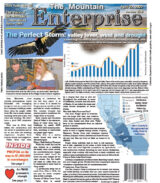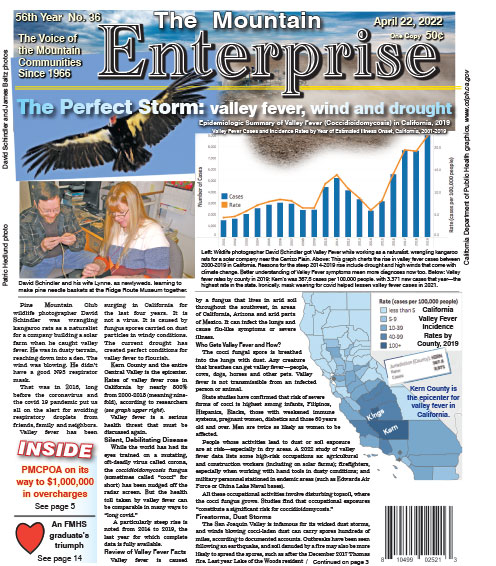—By Patric Hedlund and Marcy Axness, TME
Pine Mountain Club wildlife photographer David Schindler was wrangling kangaroo rats as a naturalist for a company building a solar farm when he caught valley fever. He was in dusty terrain, reaching down into a den. The wind was blowing. He didn’t have a good N95 respirator mask.
That was in 2016, long before the coronavirus and the covid 19 pandemic put us all on the alert for avoiding respiratory droplets from friends, family and neighbors.
Valley fever has been surging in California for the last four years. It is not a virus. It is caused by fungus spores carried on dust particles in windy conditions. The current drought has created perfect conditions for valley fever to flourish.
Kern County and the entire Central Valley is the epicenter. Rates of valley fever rose in California by nearly 800% from 2000-2018 (meaning nine-fold), according to researchers (see graph upper right).
Valley fever is a serious health threat that must be discussed again.
Silent, Debilitating Disease
While the world has had its eyes trained on a mutating, oft-deadly virus called corona, the coccidioidomycosis fungus (sometimes called “cocci” for short) has been nudged off the radar screen. But the health toll taken by valley fever can be comparable in many ways to…(please see below to view full stories and photographs)
Photo captions:
David Schindler and his wife Lynne, as newlyweds, learning to make pine needle baskets at the Ridge Route Museum together.
Epidemiologic Summary of Valley Fever (Coccidioidomycosis) in California, 2019
Valley Fever Cases and Incidence Rates by Year of Estimated Illness Onset, California, 2001-2019
Wildlife photographer David Schindler got Valley Fever while working as a naturalist, wrangling kangaroo rats for a solar company near the Carrizo Plain. Above: This graph charts the rise in valley fever cases between 2000-2019 in California. Reasons for the steep 2014-2019 rise include drought and high winds that come with climate change. Better understanding of Valley Fever symptoms mean more diagnoses now too. Below: Valley fever rates by county in 2019: Kern’s was 367.5 cases per 100,000 people, with 3,371 new cases that year—the highest rate in the state. Ironically, mask wearing for covid helped lessen valley fever cases in 2021.
Kern County is the epicenter for valley fever in California.
Turning the soil, as in agricultural or construction work, is a recipe for valley fever’s cocci spore exposure.
To see full stories with photos, please purchase a copy of the newspaper at many locations (click this link for a list) throughout the Mountain Communities.
Or, have your newspaper delivered via mail and include internet access. Just call 661-245-3794. Classified ads are FREE to paid subscribers! See front page at www.mountainenterprise.com for details.
The e-Edition is available now with full photos and stories at The Mountain Enterprise e-Edition. Select the 2022-0422 edition.
(subscriber login required)
This is part of the April 22, 2022 online edition of The Mountain Enterprise.
Have an opinion on this matter? We'd like to hear from you.

![[Photo by James Baltz]](https://mountainenterprise.com/wp-content/uploads/james-baltz-unsplash_cmyk-324x216.jpg)

